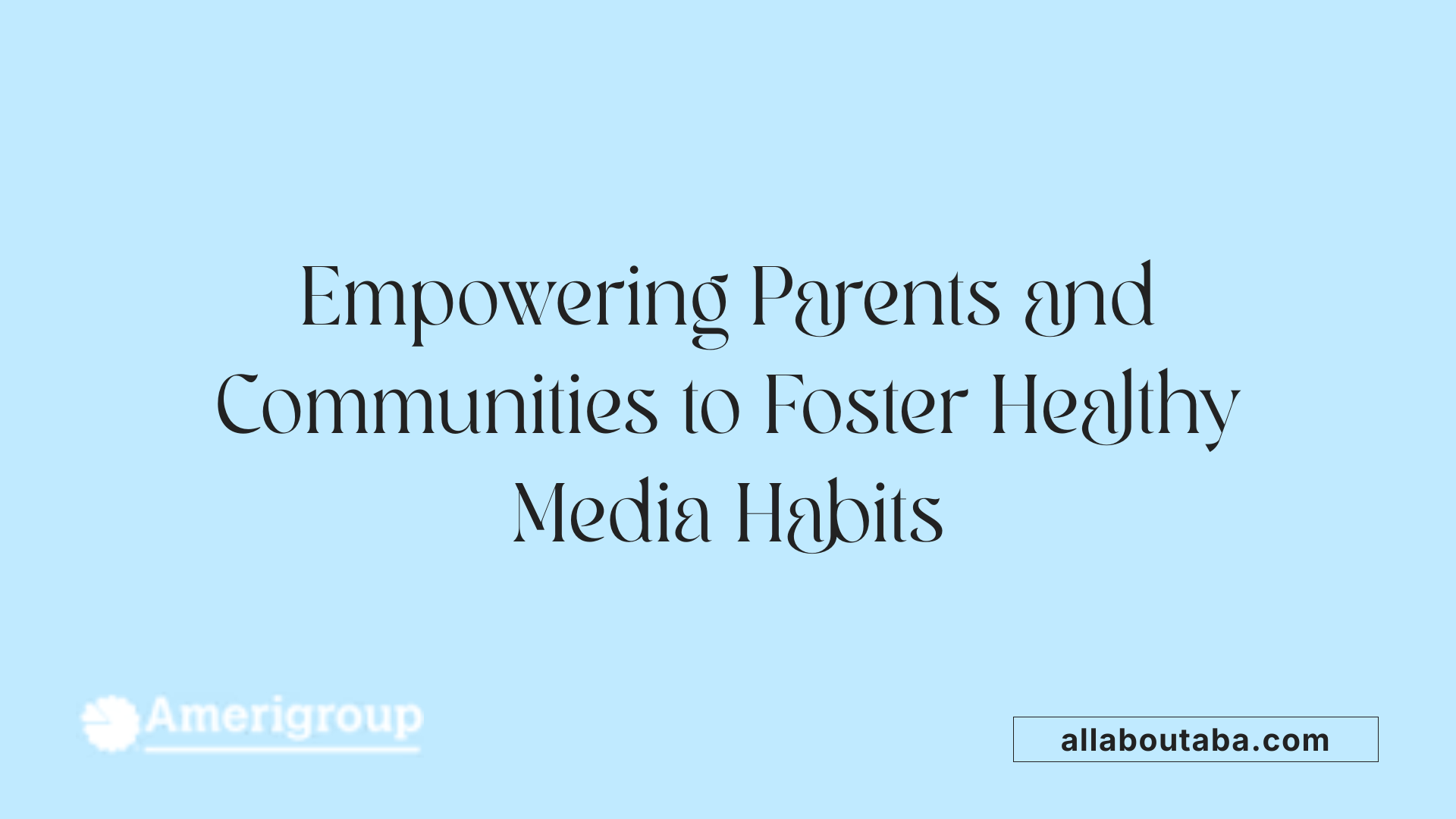Screen Time and Autism
Understanding the Complex Relationship Between Digital Media and Early Neurodevelopment
Recent scientific research indicates a nuanced connection between screen time exposure during early childhood and the development of autism spectrum disorder (ASD). While the evidence does not confirm causation, numerous studies suggest that excessive screen use might influence autism risk and exacerbate related symptoms. This comprehensive review explores the current state of research, expert recommendations, developmental considerations, and potential benefits and risks associated with screening in children, especially those with or at risk for autism spectrum disorder.
Early Exposure to Screens and Autism Risk

What is the correlation between early screen exposure (before age 2) and ASD?
Research suggests a significant association between screen time in infancy and the likelihood of developing autism spectrum disorder (ASD). Several studies, including a large cohort from the Longitudinal Study of Australian Children, have demonstrated that children with more than 14 hours of weekly screen time at age 2 are more likely to be diagnosed with ASD by age 12. This increased risk is particularly evident in boys, where longer exposure correlates with higher odds of ASD diagnosis.
Additional international research, such as in Japan and China, supports the notion that early screen habits impact neurodevelopment. For example, higher screen time at 1 year of age predicted autism diagnosis at age 3, with further associations found between longer early screen use and increased severity of autism symptoms later in childhood.
However, understanding causation remains complex. Some analyses indicate socioeconomic factors and parental habits significantly influence this relationship, suggesting that screens might be a marker for other underlying risk factors rather than a direct cause.
Impact of prolonged screen time during infancy and toddlerhood
Extended screen exposure during these formative years can interfere with critical brain development processes. Immature cognitive systems rely heavily on face-to-face interactions, play, singing, and reading for proper neural maturation.
Excessive media use in children under 18-24 months has been associated with delays in language, social-emotional skills, and overall developmental progress. Studies show that children who spend more than two hours daily on screens exhibit more ASD-like symptoms, including communication difficulties, sensory issues, and hyperactivity.
In particular, children exposed to screens early on tend to develop poorer social interactions and lower engagement with caregivers, which are crucial for healthy neurodevelopment. Additionally, overexposure has been linked with sleep disturbances, emotional dysregulation, and sensory overload.
Studies linking screen time duration to autism-like symptoms
Scientific investigations have used screening tools such as the Modified Checklist for Autism in Toddlers (M-CHAT) and other developmental assessments to explore these links. Results indicate that more screen time correlates with higher scores on autism screening tests, implying more pronounced autism-like features.
A systematic review analyzing 46 studies with over 560,000 participants found a small positive association between increased screen use and ASD symptoms. Key findings include:
| Study Type | Population | Findings | Notes |
|---|---|---|---|
| Cohort studies | Infants and young children | Longer screen time associated with increased ASD risk | Socioeconomic factors influence results |
| Screening reviews | General pediatric populations | Small effect size, not significant after bias correction | Complexity of causality |
| Specific focus on social media | Children and young adults with ASD | Negative association with social media engagement | Different focus of screen activity |
While associations exist, causality remains uncertain, and some studies indicate that children with ASD or early symptoms tend to engage more with screens, creating a bidirectional relationship.
Overall, limiting screen time in early childhood is recommended to promote healthy brain development and reduce the likelihood of autism spectrum disorder symptoms. Experts advocate for alternative engaging activities that foster social, emotional, and language skills during these critical periods.
The Role of Screen Time in Symptom Severity and Developmental Delays

How does screen time affect early childhood brain development and autism?
Extended exposure to screens during early childhood has been linked with a higher risk of developing autism spectrum disorder (ASD). Research indicates that children who are exposed to screens before the age of two, particularly for more than two hours daily, tend to show increased signs of ASD-related difficulties. These include challenges in communication, delayed language acquisition, and sensory processing issues.
Studies have demonstrated that reducing or replacing screen time with socially engaging activities—such as talking, playing, singing, and reading—can improve developmental trajectories. Excessive media use in young children may interfere with crucial brain development by limiting exposure to essential social and sensory stimuli that foster neural connections.
Experts emphasize the importance of controlling screen exposure to promote healthier brain growth and social skills. Recommendations from pediatric health authorities suggest limiting screen time to support optimal neurodevelopment, especially during the critical early years.
The Neurobiological and Behavioral Impact of Screen Time on Children

How does screen time affect early childhood brain development and autism?
Extended exposure to screens during early childhood has been linked with increased risks of developing autism spectrum disorder (ASD). Research indicates that children who are subjected to screen use before the age of two, especially for more than two hours daily, show a higher tendency towards ASD-related symptoms such as communication difficulties and sensory processing issues.
Studies have demonstrated that high levels of screen time can interfere with critical brain development by limiting essential social interactions, auditory stimulation, and experiential learning. These activities are vital during formative years for neural connectivity and emotional regulation.
Importantly, reducing or replacing screen time with engaging social interactions, play, and language-rich activities has been associated with improvements in developmental trajectories. For example, interventions targeting early media overexposure have led to noticeable reductions in ASD symptoms, like better eye contact, language development, and reduced repetitive behaviors.
To promote healthier neurodevelopment, experts recommend limiting screen time in young children and encouraging activities that foster real-world social and sensory experiences. Recognizing early signs and managing media exposure can play a critical role in shaping better developmental outcomes.
What does neuroimaging tell us about media exposure and brain structure?
While research using brain MRI is limited, initial findings suggest that children with excessive or unhealthy media use often exhibit structural differences in the brain. Specifically, these children tend to show less organized white and grey matter, which are crucial for efficient cognitive functions, emotional regulation, and sensory processing.
These structural changes are associated with impairments in attention, memory, and social-emotional skills. Fortunately, due to the brain's plasticity, these adverse effects can be mitigated. When problematic screen habits are modified — such as reducing screen time, increasing real-life social interaction, and promoting sensory-rich activities — positive brain changes can occur.
In neurodivergent children, tailored interventions focusing on decreasing media exposure seem promising for supporting more typical brain development. This underscores the importance of balanced media use and individualized strategies to enhance neurodevelopmental outcomes.
What behavioral consequences are linked with high media consumption?
Excessive media consumption during childhood is associated with a spectrum of behavioral and cognitive challenges. Children who engage in high levels of screen time often experience decreased attention span and heightened stress, leading to difficulties in self-regulation.
Sleep disturbances are common due to overstimulation and exposure to blue light from screens. These sleep issues can further impair cognitive functions and emotional health. Moreover, too much media can hinder language acquisition and social skill development by replacing face-to-face interactions.
Behaviorally, children with high screen exposure are more prone to sensory overload and may exhibit increased anxiety, mood swings, and even early signs of depression. The reduction of physical activity associated with prolonged screen use can also contribute to obesity and related health concerns.
Effective management involves setting boundaries, engaging children in active play, and encouraging social activities, which are essential for emotional resilience and cognitive growth.
Is media-related brain and behavioral change reversible?
Research supports the idea that media-induced changes in the brain and behavior are reversible thanks to the brain's plasticity. When problematic media habits are identified early, and interventions are implemented, positive changes can often be observed.
Replacing excessive screen time with socially oriented activities, play, and sensory engagement can lead to improvements in language skills, social communication, and emotional regulation, especially in children with developmental challenges.
Case studies have shown that reducing screen exposure can result in rapid symptom improvements, including increased eye contact, better language development, and less repetitive behavior. Such improvements highlight the importance of early, consistent intervention.
Overall, while excessive media use can impact neurodevelopment, proactive steps to modify screen habits can promote recovery and foster healthier brain and behavioral outcomes.
The Role of Parental and Environmental Factors in Screen Time and Autism

How do parental education and supervision influence children’s screen exposure?
Parental education and supervision are crucial in shaping a child's media habits. Research indicates that children whose parents have lower educational levels tend to spend more time on screens. This may be due to a lack of awareness about recommended screen time limits or limited access to alternative engaging activities.
Supervision also plays a vital role. Families with less restrictive rules about screen use often see higher media exposure among children. Reliance on screens as a shortcut for child care or behavioral management can inadvertently lead to excessive use.
Furthermore, parents' own screen habits influence their children. Greater caregiver screen use correlates with increased screen time for kids, creating a digital environment where technology serves as a primary activity. Children owning independent electronic devices or having unrestricted access at home tend to surpass recommended screen time guidelines.
How do socioeconomic factors influence media habits?
Socioeconomic status (SES) significantly impacts children's screen use. Lower SES families may have fewer resources for enriching activities like sports, arts, or outdoor play, leading to increased reliance on screens for entertainment and supervision.
Studies show that children from less affluent backgrounds are exposed to more than twice the recommended screen time, partly because digital devices are accessible and affordable. Limited parental time for direct engagement, due to work commitments, can also result in higher screen exposure.
This environmental backdrop can influence developmental pathways, with some evidence suggesting a link between higher screen time and increased ASD symptoms. Socioeconomic factors may partly explain disparities in neurodevelopmental outcomes across different populations.
What interventions and strategies can promote healthier screen habits?
To manage and reduce excessive screen time, families can adopt several strategies:
- Establish Clear Routines: Set specific times for screen use, such as after homework or household chores, and designate screen-free zones like bedrooms and dining areas.
- Use Device Controls: Utilize parental controls and app timers to limit daily usage and prevent overexposure.
- Emphasize Offline Activities: Encourage play, reading, and outdoor experiences to promote physical activity and social interaction.
- Educate Caregivers: Provide information through pediatric visits or community programs about recommended screen time and potential developmental impacts.
- Promote Parent-Child Engagement: Regularly engage in talking, singing, and shared activities that foster bonding and communication.
- Tailor Approaches to Individual Needs: Consider each child's developmental status and sensitivities, especially for those with or at risk for autism.
Professionals such as pediatricians, educators, and therapists can support families by creating personalized plans that balance screen time with essential social and cognitive activities.
Does socioeconomic status influence the relationship between screen time and autism?
Socioeconomic factors indeed modulate the connection between screen exposure and autism risk. Lower SES is often associated with increased screen time due to a combination of factors such as limited access to alternative recreational activities, less parental supervision, or reliance on digital devices for childcare.
These environmental influences can contribute to developmental delays and autism spectrum symptoms. Research suggests that when controlling for socioeconomic factors, some of the observable associations between early screen time and autism diminish but do not disappear entirely.
Therefore, public health strategies aiming to reduce excessive digital media use must also address underlying socioeconomic disparities. Improving access to engaging, developmentally appropriate activities and supporting parental education are essential for mitigating these risks.
| Factors Influencing Screen Time | Impact | Notes |
|---|---|---|
| Parental education level | Longer screen exposure in children | Lower education correlates with less awareness of guidelines |
| Guardian monitoring and restriction | Lower restrictions lead to increased use | Less supervision associated with higher screen time |
| Caregiver screen habits | Higher parent screen use correlates with children’s habits | Family environment shapes media behaviors |
| Child ownership of devices | Independent device use increases exposure | Greater access equals longer use |
| Socioeconomic status | Disparities in access and supervision | Lower SES often linked to higher exposure |
Understanding these influences helps target interventions more effectively, promoting healthier development and potentially reducing autism risk.
Navigating Digital Media in Childhood: A Balanced Approach
While the research on screen time and autism continues to evolve, current evidence highlights both risks and potential benefits. Excessive or poorly managed digital media exposure in early childhood—particularly before age two—may increase the risk or severity of autism-related symptoms, while moderated use and integrated social activities can support healthy development. Experts recommend tailored strategies that involve parental guidance, environmental adjustments, and therapeutic interventions to optimize outcomes. Recognizing the individual needs of children, especially those with or at risk for autism, is crucial in fostering resilient, socially engaged, and cognitively healthy future generations. Ongoing research and clinical guidance will be vital in refining best practices for managing screen time in the context of early childhood neurodevelopment.
References
- Early Screen-Time Exposure and Its Association With Risk of ...
- Screen Time Before 2 Years of Age and Risk of Autism at 12 Years ...
- Early Childhood Screen Time, Brain Development, and Autism - AAP
- Neurodivergent Kids and Screen Time - Child Mind Institute
- Screen Time and Autism Spectrum Disorder: A Systematic Review ...
- Autism and screen time: Are they related? - Norton Children's
- Screen Time and Social Engagement in Early Childhood Development
- Changes in autism symptoms associated with screen exposure
- Association Between Screen Time Exposure in Children at 1 Year of ...
Other articles
Recent articles

Best Practices For Telehealth Autism Therapy

How To Help Autistic Children Develop Friendship Skills

How Schools Can Support Autistic Students In Career Prep

Best Strategies For Autism-Friendly Event Planning

Understanding Noncontingent Reinforcement In Autism Behavior Plans

How Drama Therapy Benefits Autistic Individuals

Best Practices For Autism-Friendly Fitness And Recreation Centers

Best Ways To Promote Healthy Social Media Use For Autistic Teens

How To Help Autistic Children Cope With Public Speaking

Autism And Strategies For Managing Unexpected Changes

Best Podcasts About Autism For Parents And Educators

Autism And The Impact Of Seasonal Changes On Behavior

The Role Of Diet In Managing Co-Occurring Conditions With Autism

Sleep Challenges In Autism And Practical Solutions

Best Ways To Build Daily Routines For Autistic Children

Best Practices For Supporting Autistic Entrepreneurs

Autism And Strategies For Navigating Large Social Gatherings

Adaptive Sports And Recreational Activities For People With Autism

Autism And The Benefits Of Story-Based Learning Activities

Understanding The Role Of Play In Autism Development

Autism And The Impact Of Environmental Noise On Learning

How To Create Autism-Friendly Community Spaces

Autism And Chronic Health Conditions: What To Know

The Role Of Care Managers In Autism Life Planning

How To Teach Social Boundaries To Autistic Children

How Autistic Individuals Experience Empathy Differently

How To Support Autistic Employees In Remote Work Settings

Autism And The Relationship Between Motor Skills And Learning

How To Create Community Resource Guides For Autism Families

How To Teach Daily Living Skills To Autistic Teens

Autism And The Impact Of Mind-Body Practices On Stress Reduction

Autism And The Benefits Of Outdoor Group Activities

How To Create Autism-Friendly Sensory Paths In Schools

Best Practices For Autism-Friendly Park And Recreation Areas

Autism And Strategies For Reducing School Refusal

Supporting Autistic Individuals In Public Speaking

The Role Of Diet In Managing Autism Symptoms

The Benefits Of Gardening Clubs For Autism Social Development

How To Prepare Autistic Children For Dental Visits

Autism And Employment: Career Paths That Work

Best Practices For Autism-Friendly Hotels And Lodging

The Impact Of Screen Time On Autism Development

Autism Screening Tools For Early Childhood

The Role Of Physical Exercise In Autism Therapy

Best Strategies For Supporting Autistic College Students

The Role Of Technology In Autism Early Detection

Sensory-Friendly Classroom Design Ideas For Autistic Students

The Role Of Speech Therapy In Building Social Communication Skills

Best Strategies For Handling Autistic Burnout In Adults

Autism And The Importance Of Predictability In Routine

Autism And Peer Education: Teaching Acceptance In Schools

Best Practices For Sensory-Friendly Libraries And Reading Rooms

Self-Advocacy Skills For Autistic Adults

The Role Of Technology In Autism Peer Communication

Promoting Physical Activity In Children With Autism

How To Prepare Autistic Children For Medical Procedures

The Role Of Social Media In Autism Advocacy And Awareness

The Impact Of Sensory Rooms In Public Facilities For Autism

How To Create An Autism-Friendly Holiday Celebration

Best Practices For Inclusive Education For Autistic Students

Autism And Mental Health: Recognizing Signs Of Distress

Best Practices For Sensory-Friendly Waiting Rooms

The Role Of Teachers In Early Autism Red Flag Identification

Autism-Friendly Housing Design Features

Autism-Friendly Housing Design Features

How Environmental Modifications Improve Autism Outcomes

Autism And Technology-Based Learning Tools

Supporting Autistic Children Through Changes In Routine

The Link Between Autism And Working Memory Challenges

Best Practices For Autism-Friendly Cooking Classes

Autism And The Benefits Of Structured Music Lessons

Best Books To Teach Kids About Autism Acceptance

Sensory Diets And Their Benefits For Autism Management

How To Prepare Autistic Teens For Driver’s Education

How To Teach Autistic Teens About Healthy Relationships

The Role Of Visual Prompts In Building Daily Habits For Autism

Addressing Sleep Regression In Children With Autism

Understanding Social Stories And How They Help Autistic Children

Navigating Insurance Coverage For Autism Therapy Services

How To Prepare Autistic Adults For Independent Travel

Supporting Autistic Individuals In Volunteer Work

How Mindfulness Practices Can Support Autism Well-Being

Understanding Hyperfocus And Special Interests In Autism

Understanding Stimming As A Self-Regulation Tool

Sensory-Based Interventions For Autism At Home

Best Ways To Introduce Self-Advocacy In Autistic Teens

Best Ways To Support Autistic Employees In Customer Service Roles

Best Practices For Autism-Friendly Volunteer Programs

Autism And The Benefits Of Sensory Play For Emotional Growth

Autism And Strategies For Building Peer Relationships

Understanding How Autism Affects Memory Processing

Autism And Strategies For Building Coping Skills In Teens

The Role Of Parent Training In Autism Intervention Programs

Autism-Friendly Workplace Accommodations

Using Visual Timers For Autism Time Management

What Is ABA Therapy?

Autism and Sleep

Do Plastic Toys Cause Autism?

Autism Facial Expressions

Autism and Motor Skills
We’re All About You, Your Family, and Your Child

